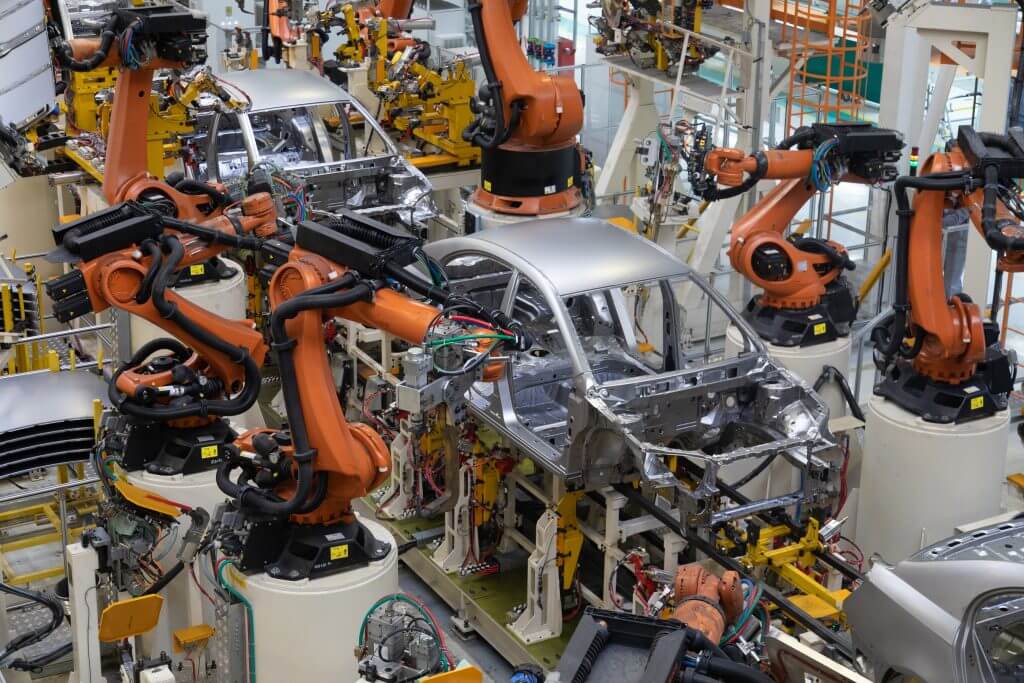TECHNOLOGY
The Evolution of the Assembly Line Continues With Robotics

Robots are powering the evolution of the assembly line.
Modern manufacturing is built on the assembly line model, but it has changed significantly over the years. Without technological advances, we wouldn’t have easy access to all kinds of products, such as cars or appliances. Robots are at the forefront of manufacturing today.
Here’s a look at where assembly line tech has been and where it is going in the future with today’s advancements in robotics.

The Evolution of the Assembly Line
Imagine trying to paint an entire building. It might take one person 20 hours to finish the job. On the other hand, 20 people could finish it in just one hour. This is the principle behind assembly lines, the manufacturing strategy that has built the modern world. Products are manufactured using a set of standardised parts. The product moves through the process in stages, with a new component added at every one.
Assembly lines are highly efficient, whether humans or robots are doing the work. In fact, they completely changed the world when they first became popular, resulting in the Industrial Revolution.
The First Industrial Revolution took off in the mid-18th century in the U.K. and gradually made its way to Europe and North America soon after. It saw the introduction of steam power and advances in textile manufacturing, which would later lead to the widespread use of assembly lines.
The assembly line really took off in the early 20th century, when Ransom Olds and Henry Ford pioneered automobile assembly line manufacturing. The two competing car companies successfully used assembly lines, although the Ford brand ultimately outlived Oldsmobile. By WWII, assembly lines were a crucial part of manufacturing in virtually every industry.
These early assembly lines relied on human employees to carry out each step of the process. In the mid-20th century, robots began to revolutionise the manufacturing world.
The Rise of Robotics
Assembly line manufacturing was undoubtedly a good idea — a team of people could quickly and efficiently put products together. Skilled artisans were no longer required. Plus, assembly lines could make products faster and with better consistency from one unit to another. Since the products used standardised parts, things like guns, tools and cars were also easier to repair.
However, the assembly line still needed to evolve. That’s why robots were introduced to manufacturing in the mid-20th century. The first successful industrial bot was the Unimate, developed by Unimation Inc. for the General Motors automobile assembly line. It was installed in 1961 at GM’s Trenton, New Jersey, plant. This began the rise of machinery in manufacturing. Today, industrial robots are booming — the global industrial robotics market is projected to be worth USD 81 billion by 2028.
Robots mark a critical turning point in the evolution of the assembly line. They allow assembly lines to be safer. Worker safety was a major issue in the early Industrial Revolution, especially while child labour remained commonplace worldwide. Robotics means employees no longer needed to handle dangerous parts or tasks.
Robots improved assembly line efficiency, as well. Manufacturers quickly realised machines could operate with much greater consistency than a human could. Human error could lead to lost revenue and pose a serious safety risk on the manufacturing floor, which was dangerous to begin with. Robots solved these problems. They can perform the same task repeatedly without suffering from fatigue or loss of focus.
Automated Assembly Lines
Early manufacturing robots like the Unimate were more like mechanical avatars for employees. Workers were still needed to operate them in real-time. Many manufacturing robots still work this way today, but things are changing. Automation is the most recent revolutionary technology in the evolution of the assembly line.
Computers, programming and AI have enabled manufacturing robots to advance over recent years, removing human operators from the process. Automation adds a layer of intelligence to mechanical robotic systems and allows them to run independently. In many ways, it has unlocked the full potential of robots on the assembly line.
Automation can take several forms. It might be as simple as using an automation software application to programme a robot to run independently. AI could also be used to automate assembly line bots. AI algorithms can use various sensors to collect information about their environment and adjust their actions accordingly. They can also use machine learning to improve performance and learn new skills. These capabilities are invaluable for manufacturers in all kinds of industries.
For instance, a gardening supply manufacturer may need to package fertiliser into plastic jars. Employees could do this by hand, but that would be expensive and time-consuming. Robots can speed up the process, although it would require some way to ensure precision. Otherwise, fertiliser would be spilt in the process of getting it into the jar, which would waste resources.
Automation is the key. The gardening supply manufacturer could use AI-powered robots to effectively and efficiently fill their jars with fertiliser. There are many ways to do this. For instance, an AI camera could use computer vision to “see” the jar’s opening and precisely navigate a robotic dispenser over that opening. Similarly, smart automation software could be used to programme the robot to only pour a certain amount of fertiliser or navigate to a precise location over a conveyor belt of empty jars.
Automation in this situation enables improved quality and reduced labour costs, two of the biggest benefits of automation. Software allows a robot to fill the fertiliser jars without human supervision, so the gardening supply manufacturer can operate with fewer employees and use resources better. Automated robots reduce the impact of human error, strengthen productivity and improve quality consistency.
Machines can perform the same task innumerable times with the same quality consistency. Automation and AI add intelligence to robotic processes, improving precision so results are consistent and satisfactory.
AI automation is gaining popularity in some of the largest manufacturing facilities in the world. For example, Ford is pioneering an advanced automation AI in its assembly line robots. Ford’s AI robots use machine learning to improve their performance over time, becoming more precise, accurate and dexterous. These capabilities allow manufacturers to save money, operate more efficiently and produce higher quality products.
Cobots: The Future of the Assembly Line
The evolution of the assembly line is still underway. AI automation is a breakthrough for manufacturing. It is especially important today since many companies are facing labour shortages. In fact, the National Association of Manufacturers estimates that the industry will be short 2.1 million workers by 2030. Automation and robotics are key to filling the gap.
Manufacturers have realised that robots can’t replace all human employees. Many tasks require creativity and an eye for detail, which people are much better suited for than machines. The assembly line needs a combination of humans and robots to reach its full potential.
Unfortunately, robots can sometimes pose safety hazards to people. Assembly line bots are often large, powerful machines. Many manufacturers keep them isolated from employees in fenced-off areas. This keeps workers from accidentally straying into a robot’s area of operation and potentially getting injured. However, it isn’t ideal for a robot-human collaborative workplace.
This is where collaborative robots, or cobots, come in. Cobots are the next evolution of the assembly line and the future of manufacturing. They are specifically designed to work safely alongside humans. For instance, a cobot robotic arm might have sensors that detect where people are standing nearby. Features like this maximise the potential for machines and humans to work together while minimising the risk of injury in the process. As collaborative robots gain popularity, they will help transform assembly lines to meet modern demand, even with smaller teams of employees.
Assembly Lines Build Our World
The evolution of the assembly line plays a key role in modern technology. This form of manufacturing has allowed countless products to be created in an affordable, accessible way. Without them, only the wealthy could have things like cars, appliances and personal computers.
Robots are powering the evolution of the assembly line today and into the future. They have made work safer, more efficient, and more accurate and precise.
Source link
TECHNOLOGY
Next-gen chips, Amazon Q, and speedy S3

AWS re:Invent, which has been taking place from November 27 and runs to December 1, has had its usual plethora of announcements: a total of 21 at time of print.
Perhaps not surprisingly, given the huge potential impact of generative AI – ChatGPT officially turns one year old today – a lot of focus has been on the AI side for AWS’ announcements, including a major partnership inked with NVIDIA across infrastructure, software, and services.
Yet there has been plenty more announced at the Las Vegas jamboree besides. Here, CloudTech rounds up the best of the rest:
Next-generation chips
This was the other major AI-focused announcement at re:Invent: the launch of two new chips, AWS Graviton4 and AWS Trainium2, for training and running AI and machine learning (ML) models, among other customer workloads. Graviton4 shapes up against its predecessor with 30% better compute performance, 50% more cores and 75% more memory bandwidth, while Trainium2 delivers up to four times faster training than before and will be able to be deployed in EC2 UltraClusters of up to 100,000 chips.
The EC2 UltraClusters are designed to ‘deliver the highest performance, most energy efficient AI model training infrastructure in the cloud’, as AWS puts it. With it, customers will be able to train large language models in ‘a fraction of the time’, as well as double energy efficiency.
As ever, AWS offers customers who are already utilising these tools. Databricks, Epic and SAP are among the companies cited as using the new AWS-designed chips.
Zero-ETL integrations
AWS announced new Amazon Aurora PostgreSQL, Amazon DynamoDB, and Amazon Relational Database Services (Amazon RDS) for MySQL integrations with Amazon Redshift, AWS’ cloud data warehouse. The zero-ETL integrations – eliminating the need to build ETL (extract, transform, load) data pipelines – make it easier to connect and analyse transactional data across various relational and non-relational databases in Amazon Redshift.
A simple example of how zero-ETL functions can be seen is in a hypothetical company which stores transactional data – time of transaction, items bought, where the transaction occurred – in a relational database, but use another analytics tool to analyse data in a non-relational database. To connect it all up, companies would previously have to construct ETL data pipelines which are a time and money sink.
The latest integrations “build on AWS’s zero-ETL foundation… so customers can quickly and easily connect all of their data, no matter where it lives,” the company said.
Amazon S3 Express One Zone
AWS announced the general availability of Amazon S3 Express One Zone, a new storage class purpose-built for customers’ most frequently-accessed data. Data access speed is up to 10 times faster and request costs up to 50% lower than standard S3. Companies can also opt to collocate their Amazon S3 Express One Zone data in the same availability zone as their compute resources.
Companies and partners who are using Amazon S3 Express One Zone include ChaosSearch, Cloudera, and Pinterest.
Amazon Q
A new product, and an interesting pivot, again with generative AI at its core. Amazon Q was announced as a ‘new type of generative AI-powered assistant’ which can be tailored to a customer’s business. “Customers can get fast, relevant answers to pressing questions, generate content, and take actions – all informed by a customer’s information repositories, code, and enterprise systems,” AWS added. The service also can assist companies building on AWS, as well as companies using AWS applications for business intelligence, contact centres, and supply chain management.
Customers cited as early adopters include Accenture, BMW and Wunderkind.
Want to learn more about cybersecurity and the cloud from industry leaders? Check out Cyber Security & Cloud Expo taking place in Amsterdam, California, and London. Explore other upcoming enterprise technology events and webinars powered by TechForge here.
TECHNOLOGY
HCLTech and Cisco create collaborative hybrid workplaces

Digital comms specialist Cisco and global tech firm HCLTech have teamed up to launch Meeting-Rooms-as-a-Service (MRaaS).
Available on a subscription model, this solution modernises legacy meeting rooms and enables users to join meetings from any meeting solution provider using Webex devices.
The MRaaS solution helps enterprises simplify the design, implementation and maintenance of integrated meeting rooms, enabling seamless collaboration for their globally distributed hybrid workforces.
Rakshit Ghura, senior VP and Global head of digital workplace services, HCLTech, said: “MRaaS combines our consulting and managed services expertise with Cisco’s proficiency in Webex devices to change the way employees conceptualise, organise and interact in a collaborative environment for a modern hybrid work model.
“The common vision of our partnership is to elevate the collaboration experience at work and drive productivity through modern meeting rooms.”
Alexandra Zagury, VP of partner managed and as-a-Service Sales at Cisco, said: “Our partnership with HCLTech helps our clients transform their offices through cost-effective managed services that support the ongoing evolution of workspaces.
“As we reimagine the modern office, we are making it easier to support collaboration and productivity among workers, whether they are in the office or elsewhere.”
Cisco’s Webex collaboration devices harness the power of artificial intelligence to offer intuitive, seamless collaboration experiences, enabling meeting rooms with smart features such as meeting zones, intelligent people framing, optimised attendee audio and background noise removal, among others.
Want to learn more about cybersecurity and the cloud from industry leaders? Check out Cyber Security & Cloud Expo taking place in Amsterdam, California, and London. Explore other upcoming enterprise technology events and webinars powered by TechForge here.
TECHNOLOGY
Canonical releases low-touch private cloud MicroCloud

Canonical has announced the general availability of MicroCloud, a low-touch, open source cloud solution. MicroCloud is part of Canonical’s growing cloud infrastructure portfolio.
It is purpose-built for scalable clusters and edge deployments for all types of enterprises. It is designed with simplicity, security and automation in mind, minimising the time and effort to both deploy and maintain it. Conveniently, enterprise support for MicroCloud is offered as part of Canonical’s Ubuntu Pro subscription, with several support tiers available, and priced per node.
MicroClouds are optimised for repeatable and reliable remote deployments. A single command initiates the orchestration and clustering of various components with minimal involvement by the user, resulting in a fully functional cloud within minutes. This simplified deployment process significantly reduces the barrier to entry, putting a production-grade cloud at everyone’s fingertips.
Juan Manuel Ventura, head of architectures & technologies at Spindox, said: “Cloud computing is not only about technology, it’s the beating heart of any modern industrial transformation, driving agility and innovation. Our mission is to provide our customers with the most effective ways to innovate and bring value; having a complexity-free cloud infrastructure is one important piece of that puzzle. With MicroCloud, the focus shifts away from struggling with cloud operations to solving real business challenges” says
In addition to seamless deployment, MicroCloud prioritises security and ease of maintenance. All MicroCloud components are built with strict confinement for increased security, with over-the-air transactional updates that preserve data and roll back on errors automatically. Upgrades to newer versions are handled automatically and without downtime, with the mechanisms to hold or schedule them as needed.
With this approach, MicroCloud caters to both on-premise clouds but also edge deployments at remote locations, allowing organisations to use the same infrastructure primitives and services wherever they are needed. It is suitable for business-in-branch office locations or industrial use inside a factory, as well as distributed locations where the focus is on replicability and unattended operations.
Cedric Gegout, VP of product at Canonical, said: “As data becomes more distributed, the infrastructure has to follow. Cloud computing is now distributed, spanning across data centres, far and near edge computing appliances. MicroCloud is our answer to that.
“By packaging known infrastructure primitives in a portable and unattended way, we are delivering a simpler, more prescriptive cloud experience that makes zero-ops a reality for many Industries.“
MicroCloud’s lightweight architecture makes it usable on both commodity and high-end hardware, with several ways to further reduce its footprint depending on your workload needs. In addition to the standard Ubuntu Server or Desktop, MicroClouds can be run on Ubuntu Core – a lightweight OS optimised for the edge. With Ubuntu Core, MicroClouds are a perfect solution for far-edge locations with limited computing capabilities. Users can choose to run their workloads using Kubernetes or via system containers. System containers based on LXD behave similarly to traditional VMs but consume fewer resources while providing bare-metal performance.
Coupled with Canonical’s Ubuntu Pro + Support subscription, MicroCloud users can benefit from an enterprise-grade open source cloud solution that is fully supported and with better economics. An Ubuntu Pro subscription offers security maintenance for the broadest collection of open-source software available from a single vendor today. It covers over 30k packages with a consistent security maintenance commitment, and additional features such as kernel livepatch, systems management at scale, certified compliance and hardening profiles enabling easy adoption for enterprises. With per-node pricing and no hidden fees, customers can rest assured that their environment is secure and supported without the expensive price tag typically associated with cloud solutions.
Want to learn more about cybersecurity and the cloud from industry leaders? Check out Cyber Security & Cloud Expo taking place in Amsterdam, California, and London. Explore other upcoming enterprise technology events and webinars powered by TechForge here.
-

 MARKETING7 days ago
MARKETING7 days agoRoundel Media Studio: What to Expect From Target’s New Self-Service Platform
-

 SEO6 days ago
SEO6 days agoGoogle Limits News Links In California Over Proposed ‘Link Tax’ Law
-
SEARCHENGINES6 days ago
Daily Search Forum Recap: April 12, 2024
-

 SEARCHENGINES5 days ago
SEARCHENGINES5 days agoGoogle Core Update Volatility, Helpful Content Update Gone, Dangerous Google Search Results & Google Ads Confusion
-

 SEO5 days ago
SEO5 days ago10 Paid Search & PPC Planning Best Practices
-

 SEO7 days ago
SEO7 days agoGoogle Unplugs “Notes on Search” Experiment
-

 MARKETING6 days ago
MARKETING6 days ago2 Ways to Take Back the Power in Your Business: Part 2
-

 MARKETING4 days ago
MARKETING4 days ago5 Psychological Tactics to Write Better Emails













You must be logged in to post a comment Login